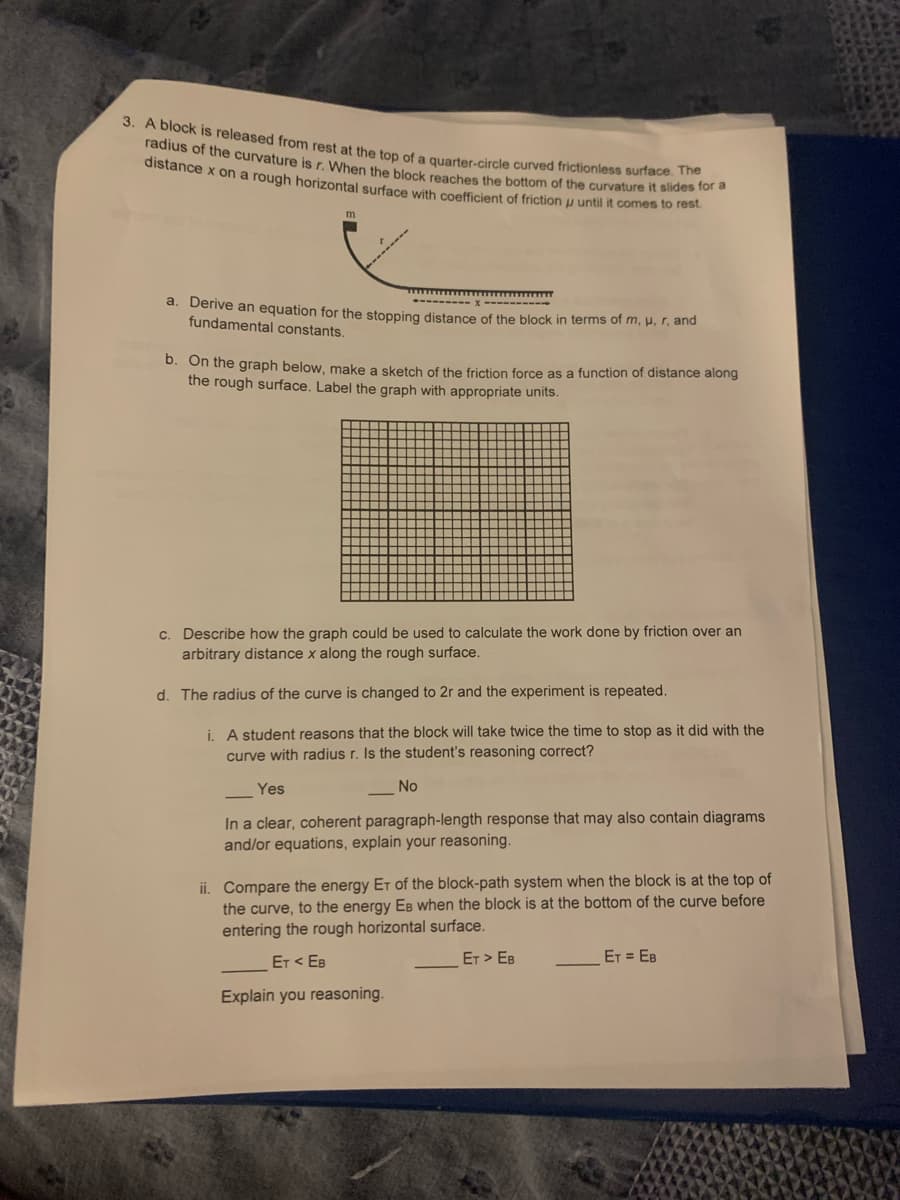3. A block is released from rest at the top of a quarter-circle curved frictionless surface. The distance x on a rough horizontal surface with coefficient of friction p until it comes to rest radius of the curvature is r. When the block reaches the bottom of the curvature it slides for a m a. Derive an equation for the stopping distance of the block in terms of m, u, r, and fundamental constants. D. On the graph below, make a sketch of the friction force as a function of distance along the rough surface. Label the graph with appropriate units. c. Describe how the graph could be used to calculate the work done by friction over an arbitrary distance x along the rough surface. d. The radius of the curve is changed to 2r and the experiment is repeated. i. A student reasons that the block will take twice the time to stop as it did with the curve with radius r. Is the student's reasoning correct? Yes No In a clear, coherent paragraph-length response that may also contain diagrams and/or equations, explain your reasoning. ii. Compare the energy ET of the block-path system when the block is at the top of the curve, to the energy EB when the block is at the bottom of the curve before entering the rough horizontal surface. ET < EB ET > EB ET = EB - Explain you reasoning.
3. A block is released from rest at the top of a quarter-circle curved frictionless surface. The distance x on a rough horizontal surface with coefficient of friction p until it comes to rest radius of the curvature is r. When the block reaches the bottom of the curvature it slides for a m a. Derive an equation for the stopping distance of the block in terms of m, u, r, and fundamental constants. D. On the graph below, make a sketch of the friction force as a function of distance along the rough surface. Label the graph with appropriate units. c. Describe how the graph could be used to calculate the work done by friction over an arbitrary distance x along the rough surface. d. The radius of the curve is changed to 2r and the experiment is repeated. i. A student reasons that the block will take twice the time to stop as it did with the curve with radius r. Is the student's reasoning correct? Yes No In a clear, coherent paragraph-length response that may also contain diagrams and/or equations, explain your reasoning. ii. Compare the energy ET of the block-path system when the block is at the top of the curve, to the energy EB when the block is at the bottom of the curve before entering the rough horizontal surface. ET < EB ET > EB ET = EB - Explain you reasoning.
International Edition---engineering Mechanics: Statics, 4th Edition
4th Edition
ISBN:9781305501607
Author:Andrew Pytel And Jaan Kiusalaas
Publisher:Andrew Pytel And Jaan Kiusalaas
Chapter7: Dry Friction
Section: Chapter Questions
Problem 7.24P: A uniform plank is supported by a fixed support at A and a drum at B that rotates clockwise. The...
Related questions
Question
100%
Can you please answer and explain?

Transcribed Image Text:radius of the curvature is r. When the block reaches the bottom of the curvature it slides for a
3. A block is released from rest at the ton of a quarter.circle curved frictionless surface.
distance x on a rough horizontal surface with coefficient of friction µ until it comes to lese
m
d. Derive an equation for the stopping distance of the block in terms of m, u, r, and
fundamental constants.
D. On the graph below, make a sketch of the friction force as a function of distance along
the rough surface. Label the graph with appropriate units.
c. Describe how the graph could be used to calculate the work done by friction over an
arbitrary distance x along the rough surface.
d. The radius of the curve is changed to 2r and the experiment is repeated.
i. A student reasons that the block will take twice the time to stop as it did with the
curve with radius r. Is the student's reasoning correct?
Yes
No
In a clear, coherent paragraph-length response that may also contain diagrams
and/or equations, explain your reasoning.
ii. Compare the energy ET of the block-path system when the block is at the top of
the curve, to the energy EB when the block is at the bottom of the curve before
entering the rough horizontal surface.
ET < EB
ET > EB
ET = EB
Explain you reasoning.
Expert Solution
This question has been solved!
Explore an expertly crafted, step-by-step solution for a thorough understanding of key concepts.
This is a popular solution!
Trending now
This is a popular solution!
Step by step
Solved in 4 steps with 2 images

Knowledge Booster
Learn more about
Need a deep-dive on the concept behind this application? Look no further. Learn more about this topic, mechanical-engineering and related others by exploring similar questions and additional content below.Recommended textbooks for you

International Edition---engineering Mechanics: St…
Mechanical Engineering
ISBN:
9781305501607
Author:
Andrew Pytel And Jaan Kiusalaas
Publisher:
CENGAGE L

International Edition---engineering Mechanics: St…
Mechanical Engineering
ISBN:
9781305501607
Author:
Andrew Pytel And Jaan Kiusalaas
Publisher:
CENGAGE L